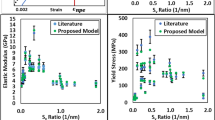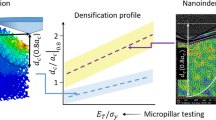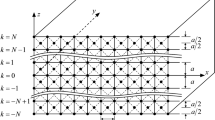Abstract
In the present research, a simple quasi-continuum model, the Cauchy-Born rule model, is used to investigate the size effects of elastic modulus for fcc metals. By considering a nanoplate model and calculating the strain energy for the nano-sized plate under tension and bending, the relationship between the elastic modulus and the plate thickness is found. Size effects of the elastic modulus are displayed by the relative differences of the elastic modulus between the nano-sized plate sample and the bulk sample. By comparing the present results with those of others, the effectiveness of the Cauchy-Born rule model in studying the size effects of material properties are shown.
Similar content being viewed by others
References
Duan, X.F., Huang, Y., Cui, Y., Wang, J.F. and Lieber, C.M., Indium phosphide nanowires as building blocks for nanoscale electronic and optoelectronic devices. Nature, 2001, 409: 66–69.
Friedman, R.S., McAlpine, M.C., Ricketts, D.S., Ham, D. and Lieber, C.M., High-speed integrated nanowire circuits. Nature, 2005, 434: 1085–1085.
Lieber, C.M. and Wang, Z.L., Functional nanowires. MRS Bulletin, 2007, 32: 99–108.
Chen, X.L., Ma, H.S., Liang, L.H. and Wei, Y.G., A surface energy model and application to mechanical behavior analysis of single crystals at sub-micron scale. Computational Materials Science, 2009, 46: 723–727.
Wei, Y.G. and Hutchinson, J.W., Hardness trends in micron scale indentation. Journal of the Mechanics and Physics of solids, 2003, 51: 2037–2056.
Villain, P., Goudeau, Ph., Renault, P.O. and Badawi, K.F., Size effect on intragranular elastic constants in thin tungsten films. Applied Physics Letters, 2002, 81: 4365–4367.
Renault, P.O., Bourhis, E.L., Villain, P., Goudeau, Ph., Badawi, K.F. and Faurie, D., Measurement of the elastic constants of textured anisotropic thin films from x-ray diffraction data. Applied Physics Letters, 2003, 83: 473–475.
Miller, R.E. and Shenoy, V.B., Size-dependent elastic properties of nanosized structural elements. Nanotechnology, 2000, 11: 139–147.
Duan, H.L., Wang, J., Huang, Z.P. and Karihaloo, B.L., Size-dependent effective elastic constants of solids containing nano-inhomogeneities with interface stress. Journal of the Mechanics and Physics of Solids, 2005, 53: 1574–1596.
Sun, C.T. and Zhang, H.T., Size-dependent elastic moduli of platelike nanomaterials. Journal of Applied Physics, 2003, 93: 1212–1218.
Zhou, L.G. and Huang, H.C., Are surface elastically softer or stiffer? Applied Physics Letters, 2004, 84: 1940–1942.
Digreville, R., Qu, J.M. and Cherkaoui, M., Surface free energy and its effect on the elastic behavior of nanosized particles, wires and films. Journal of the Mechanics and Physics of solids, 2005, 53: 1827–1854.
Dingreville, R., Kulkarni, A.J., Zhou, M. and Qu, J.M., A semi-analytical method for quantifying the size-dependent elasticity of nanostructures. Modelling and Simulation in Materials Science and Engineering, 2008, 16: 1–16.
Wang, G.F., Feng, X.Q., Yu, S.W. and Nan, C.W., Interface effects on effective elastic moduli of nanocrystalline materials. Materials Science and Engineering A, 2003, 363: 1–8.
Zhu, L. and Zheng, X.J., Modification of the elastic properties of nanostructures with surface charges in applied electric fields. European Journal of Mechanics A/solids, 2010, 29: 337–347.
Horstemeyer, M.F., Baskes, M.I. and Plimpton, S.J., Computational nano scale plasticity using embedded atom potentials. Theoretical and Applied Fracture Mechanics, 2001, 37: 49–98.
Huang, X. and Pelegri, A.A., Finite element analysis on nano indentation with friction contact at the film/substrate interface. Composites Science and Technology, 2007, 67: 1311–1319.
Xiao, S.P. and Belytschko, T., A bridging domain method for coupling continua with molecular dynamics. Computer Methods in Applied Mechanics and Engineering, 2004, 193: 1645–1669.
Born, M. and Huang, K., Dynamical Theory of Crystal Lattices, first ed. Oxford University Press, 1962.
Ericksen, J.L., The Cauchy Born Hypotheses for Crystals, Phase Transformations and Material Instabilities in Solids. In: Gurtin, M.E. (Ed.). Academic Press, 1984, 61–77.
Park, H.S. and Liu, W.K., An introduction and tutorial on multiple-scale analysis in solids. Computer Methods in Applied Mechanics and Engineering, 2004, 193: 1733–1772.
Xiao, S. and Yang, W., Temperature-related Cauchy–Born rule for multi-scale modeling of crystalline solids. Computational Material Science, 2006, 37: 374–379.
Steinmann, P., Elizondo, A. and Sunyk, R., Studies of validity of the Cauchy-Born rule by direct comparison of continuum and atomistic modeling. Modelling and Simulation in Materials Science and Engineering, 2007, 15: 271–281.
Park, H.S., Klein, P.A. and Wagner, G.J., A surface Cauchy-Born model for nanoscale materials. International Journal for Numerical Methods in Engineering, 2006, 68: 1072–1095.
Park, H.S. and Klein, P.A., Surface Cauchy-Born analysis of surface stress effects on metallic nanowires. Physical Review B, 2007, 75: 085408.
Park, H.S. and Klein, P.A., A surface Cauchy-Born model for silicon nanostructures. Computer methods in applied mechanics and engineering, 2008, 2008: 3249–3260.
Huang, Y.C., Shu, X.L., Kong, Y., Wang, L.L. and Hu, W.Y., Lattice dynamics of fcc transition metals by modified analytic embedded-atom method. The Chinese Journal of Nonferrous Metals, 2002, 12: 36–40. (in Chinese)
Chen, L., Calculation and applicability analysis for elastic constants of fcc crystal. Chinese Journal of Mechanical Engineering, 2005, 41: 46–50. (in Chinese)
Pandya, C.V., Vyas, P.R., Pandya, T.C., Rani, N. and Gohel, V.B., An improved lattice mechanical model for FCC transition metals. Physica B, 2001, 307: 138–149.
Foiles, S.M., Baskes, M.I. and Daw, M.S., Embedded-atom-method functions for the fcc metals Cu, Ag, Au, Ni, Pd, Pt, and their alloys. Physical Review B, 1986, 33: 7983–7991.
Simmons, G. and Wang, H., Single Crystal Elastic Constants and Calculated Aggregate Properties: A Handbook. MIT Press, Cambridge, 1971.
Kittel, C., Introduction to Solid State Physics. 7th edition. New York: Wiley, 1997.
Wu, B., Liang, L.H., Ma, H.S. and Wei, Y.G., A trans-scale model for size effects and intergranular fracture in nanocrystalline and ultra-fine polycrystalline metals. Computational Materials Science, 2012, 57: 2–7.
Shenoy, V.B., Atomistic calculations of elastic properties of metallic fcc crystal surfaces. Physical Review B, 2005, 71: 094104.
Author information
Authors and Affiliations
Corresponding authors
Additional information
Project supported by the National Natural Science Foundation of China (Nos. 11021262, 10932011 and 91216108) and the National Basic Research Program of China (2012CB937500). The first author (J. Liu) would like to thank the helpful advice of Dr. Wei Xu from Institute of Mechanics, Chinese Academy of Sciences.
Rights and permissions
About this article
Cite this article
Liu, J., Song, J. & Wei, Y. Size Effects of Elastic Modulus of FCC Metals Based on the Cauchy-Born Rule and Nanoplate Models. Acta Mech. Solida Sin. 27, 111–121 (2014). https://doi.org/10.1016/S0894-9166(14)60021-5
Received:
Revised:
Published:
Issue Date:
DOI: https://doi.org/10.1016/S0894-9166(14)60021-5




